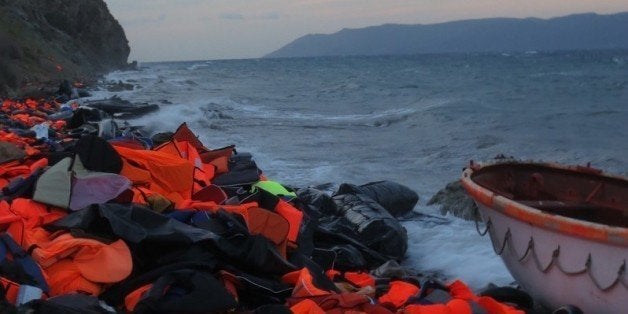
The images are indelible. A truck abandoned in the safety lane of an Austrian highway, the word HYZA painted on its side -- a picture of a chicken standing in for the Y. Inside the truck, the decomposing bodies of 71 people escaping a war.
The Turkish policeman holding the body of a small boy, bare legs dangling from beneath blue shorts. A body washed up on a beach like sea glass, flotsam from an overcrowded boat.
Some of the images move. The Hungarian camerawoman kicking at the people rushing past her lens. A camerawoman who has covered her mouth and nose with a surgical mask, as if she fears contagion from the families who live in the relocation camp she has come to film.
The seas between the countries that are at war and those that are not are littered with abandoned dinghies and life jackets. And in the air between the nations where there is no war, comes a new vocabulary. One that speaks of migrant influx and migrant quotas and shutting the migrant tap.
Then again, perhaps this vocabulary is not so new. It is said that history has a way of repeating itself. And for me, these images -- this vocabulary -- recall a story that is more than 70 years old. That of the refugee ship, the St. Louis.
The St. Louis was built to take German citizens on holidays. But in 1939 -- likely as a public relations maneuver -- Hitler allowed it to carry 900 Jews with Cuban visas across the Atlantic to Havana.
On the voyage over, these 900 Jews were treated like passengers. German waiters in white jackets brought them cold drinks and fresh towels. And if those same German waiters sat below deck and sang the Horst Wessel -- the Nazi anthem -- the 900 passengers, some of whom had recently been released from the first concentration camps, did not hear it.
"The seas between the countries that are at war and those that are not are littered with abandoned dinghies and life jackets."
For the 13 days it took to sail to Cuba, the 900 Jews aboard the St. Louis drank champagne in the Schanke bar, danced to waltzes and rhumbas in the ballroom on B deck, and believed they were going to live in a country that had no Nazis. But on the morning they arrived outside Havana harbor, the St. Louis was denied permission to dock. Public sentiment, it appeared, had convinced the Cuban president, Federico Bru, that allowing 900 Jewish refugees into his small country would not be advisable.
Forced out of Cuban waters, the St. Louis sailed along the Florida coastline, often within sight of Miami. Frantic cables were sent to the United States government, asking if there was room in the vastness of that country for 900 German Jews. Meantime, fishing boats carrying sunglass-wearing tourists motored out from Florida beaches and buzzed about the slow-moving St. Louis, near enough for the tourists to snap photos, for that is what the 900 Jews had become -- a tourist attraction.
After three days, the answer came from President Roosevelt. Our quotas are full. America has enough Jews.
On the voyage back, the 900 Jews were transformed from passengers into refugees. The white-coated waiters stopped serving them cold drinks. They brought them no towels. On occasion, they searched their rooms, tearing through their possessions. "For the safety of the crew," they said. Now and again, they called them the names the 900 had been called on the streets of Berlin and Hamburg. When the ship's doctor ran out of sleeping medication, the entire boat was put under suicide watch.
Perhaps in another public relations maneuver, Joseph Goebbels agreed to take the 900 Jews back into Germany. But before that could happen, England, France, Belgium and the Netherlands each were persuaded to take a number of them.
But this did not save the 900 Jews who boarded the St. Louis believing they would live in a country that had no Nazis. Most ended up in relocation camps, and when the war broke out, they were transformed again. This time into enemy aliens, and most were sent back to Germany, and Hitler. Only 200 or so of the 900 survived the war.
Now, when I see an photograph of a relocation camp -- turquoise tents crowded under a gray Calais sky -- or watch a video of refugees being stopped at a border by riot police, the story of the St. Louis lies beneath these images, like a historical beating heart. And while it is inconceivable that any nation opening its doors to today's refugees would consider sending them back to their devastated countries, to respond to crisis with quotas, to turn people trying to survive into a migrant influx is not so very different from transforming a passenger into a refugee and a refugee into an enemy alien.
It is possible that the story of the St. Louis is proof of the repetition of history. But it is also possible that it is the history we learn from.
Janis Cooke Newman is the author of the recently released novel, 'A Master Plan for Rescue.' She is also the founder of the Lit Camp writers conference.
Jeanne Carstensen has been reporting on the refugee crisis from Lesbos for PRI.
This post originally appeared on Medium.